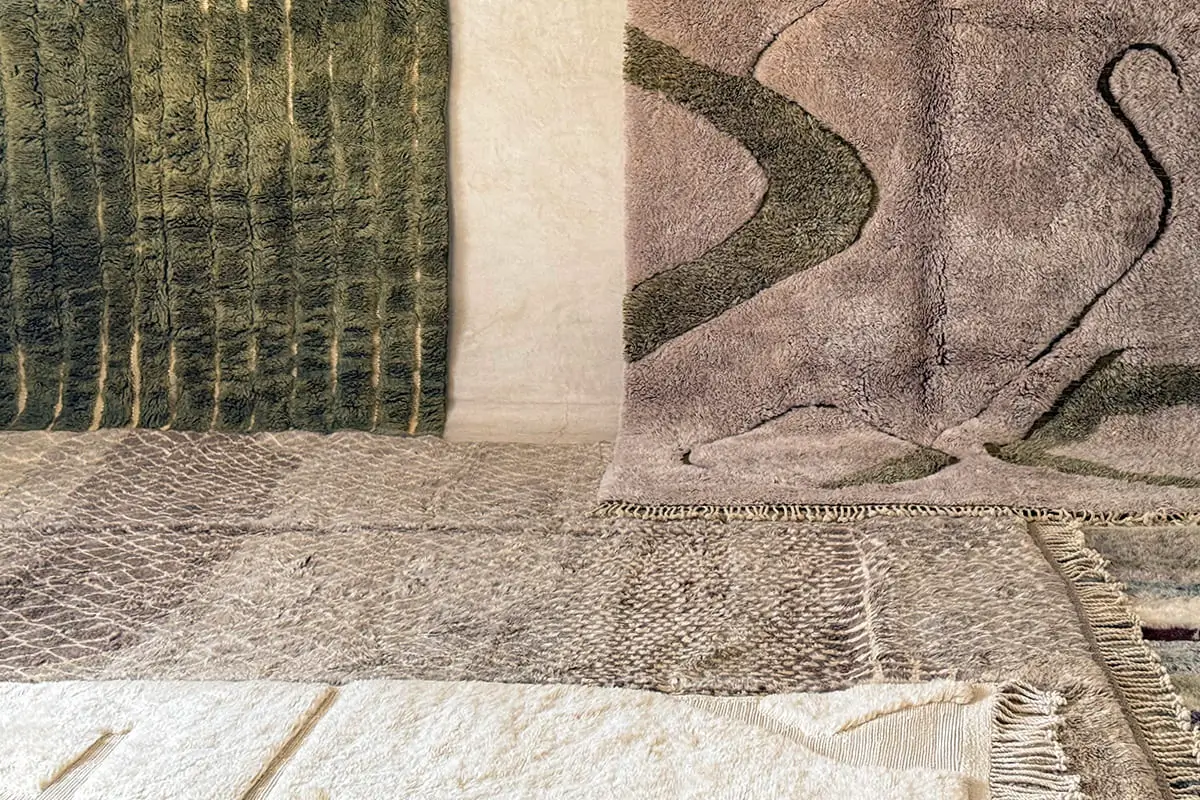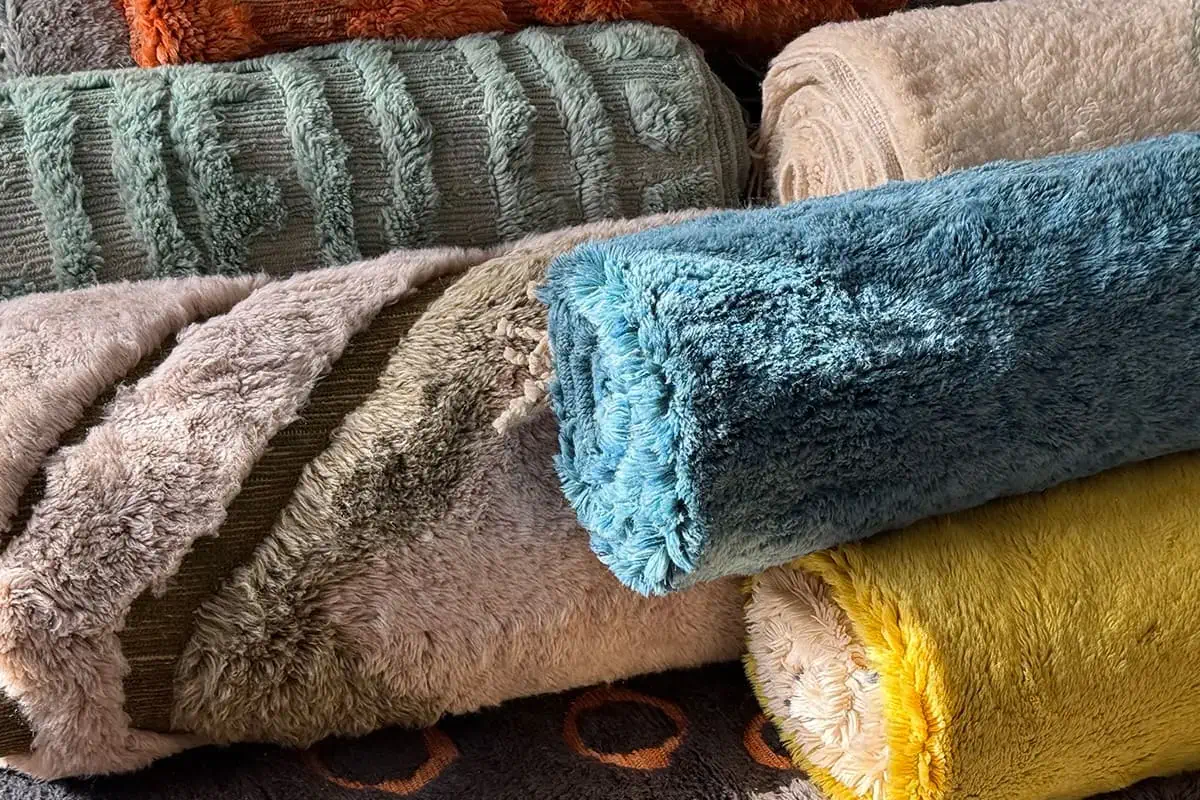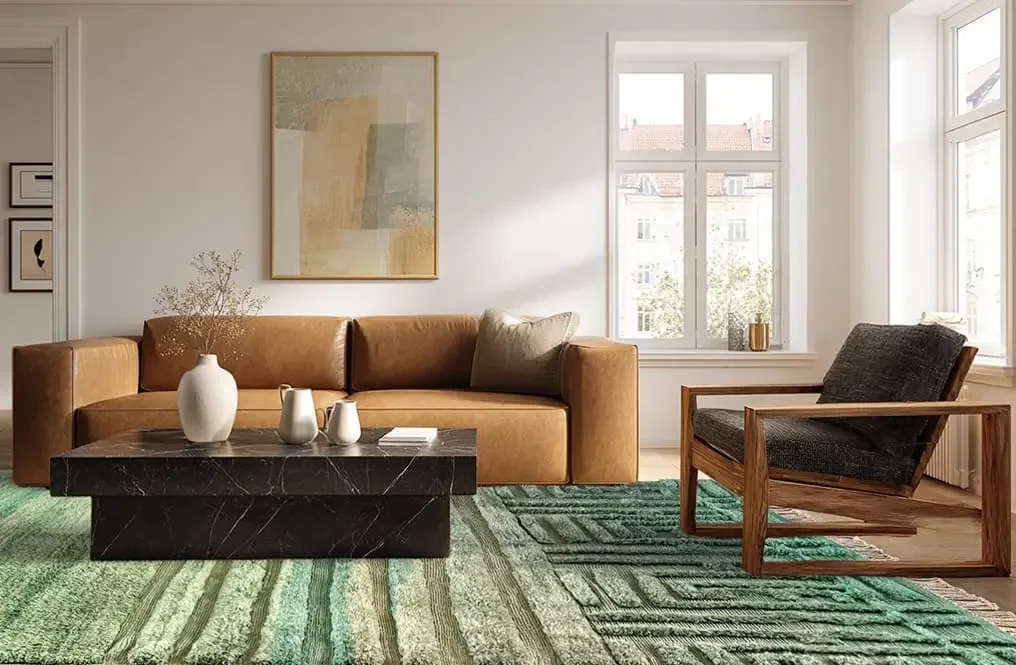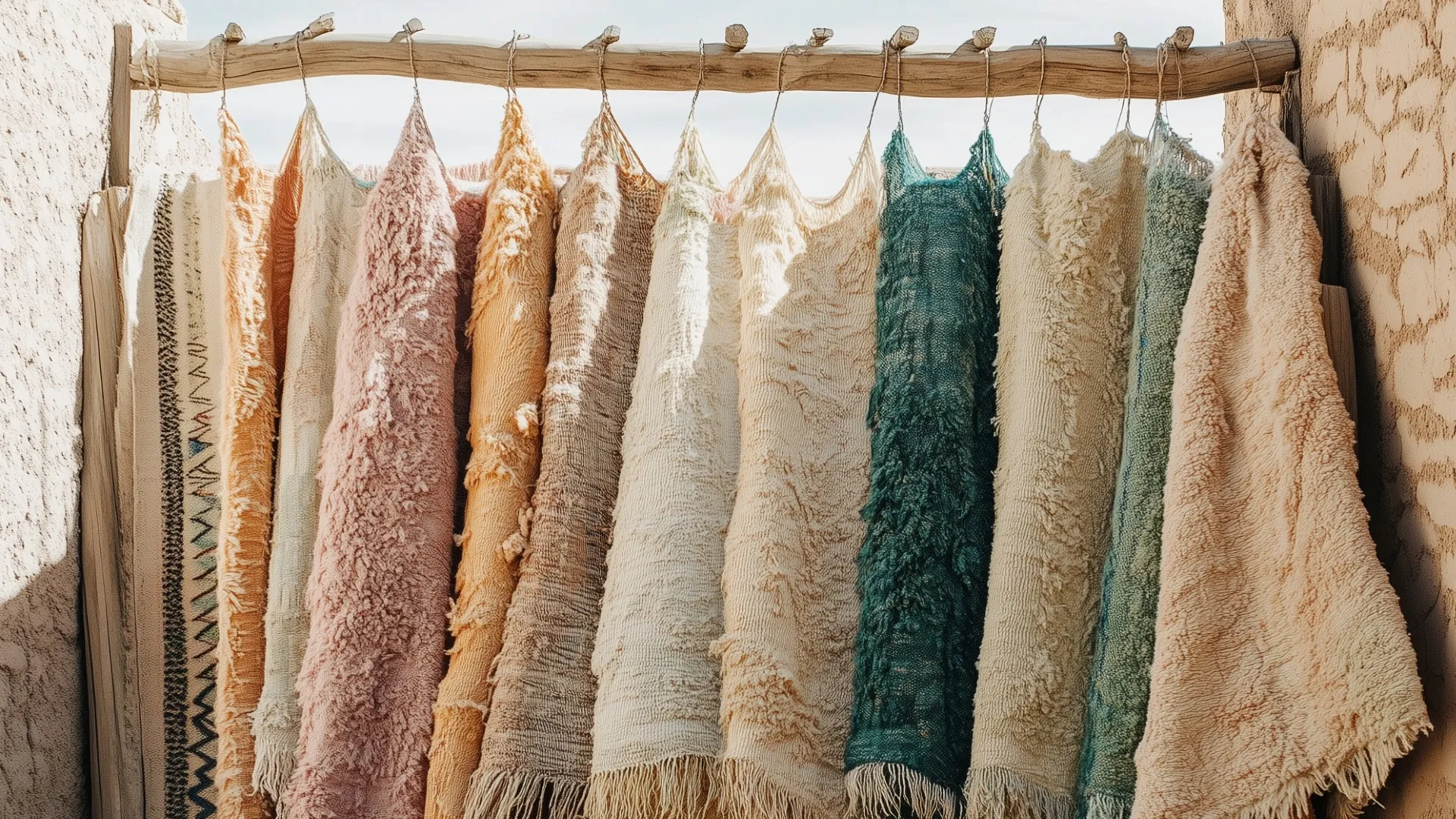Magazine

Explore All Types of Moroccan Handmade Rugs and Their Regional Distinctions
Last reviewed:
- November 11, 2025
SHARE:
A Tapestry of Landscape and Legacy
From the snow-capped Atlas Mountains to the sunbaked plains and desert plateaus, Morocco’s diverse geography has shaped a vibrant tradition of rug weaving. Each region carries its own language of color, pattern, texture, and symbolism. As a result, the types of Moroccan rugs are as varied as the landscapes themselves—woven expressions of community, history, and creative spirit. Understanding the regional distinctions behind these handmade pieces reveals not just artistic beauty, but the deep cultural stories tied to them.
As you begin to explore the regional distinctions of Moroccan rugs, take a moment to uncover the meanings hidden in the symbols themselves, Decode the Hidden Meanings in Moroccan Rug Patterns
Beni Ourain Rugs

Originating from the semi-nomadic Beni Ourain tribes of the Middle Atlas Mountains, these rugs are traditionally hand-knotted using natural ivory wool. They feature a thick pile and geometric patterns in black or brown. While historically woven with undyed wool, many contemporary versions incorporate color-enhanced yarns to expand the available palette.
Azilal Rugs
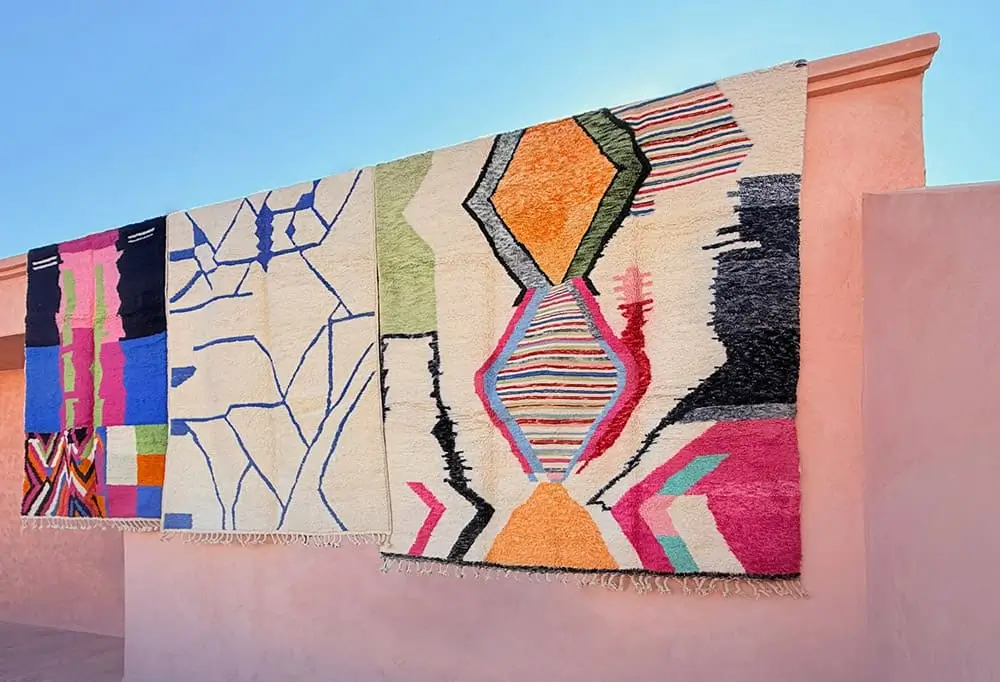
Woven in the Azilal province of the High Atlas Mountains, these rugs are made from a mix of wool and cotton and are characterized by vivid colors and asymmetrical designs. Their compositions often follow an intuitive and expressive rhythm, reflecting personal or symbolic narratives conveyed by the weavers.
Boujad Rugs
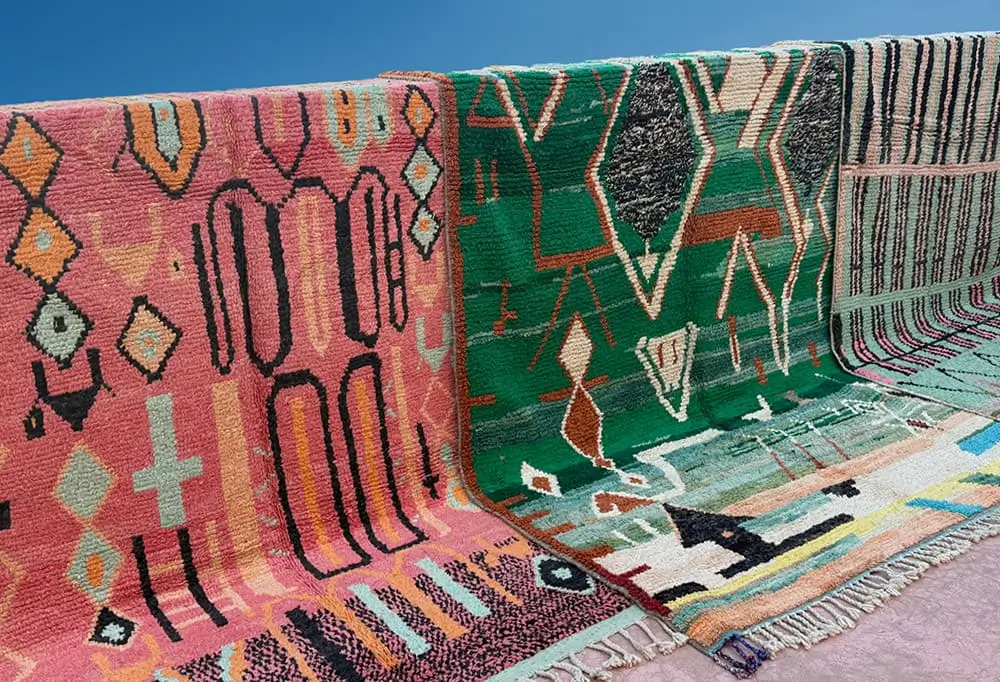
Originating in the Haouz region, Boujad rugs are known for their deep, warm hues—reds, oranges, pinks—and detailed diamond and cross motifs. These medium-pile rugs are often crafted from recycled wool and reflect traditional Berber symbolism in a vivid, romantic style. Their warmth and richness make them ideal for cozy, layered interiors.
Rehamna Rugs
Woven in the Rehamna region near Marrakech, these rugs are characterized by a dense construction and deep red-based color palettes. Their abstract and irregular designs often incorporate tribal symbols and motifs linked to personal or communal narratives.
Boucherouite Rugs
Inventive and eco-conscious, Boucherouite rugs are crafted from scraps of fabric, nylon, cotton, and wool. Made primarily by women in rural areas, these colorful patchworks defy pattern and tradition. They are joyful, spontaneous, and deeply personal, bringing a bohemian flair to modern interiors.
Kilim Rugs

Kilim rugs, also known as Hanbal or flatweave rugs depending on language and region, are thin, flatwoven textiles renowned for their lightweight structure and versatility. Crafted using a tightly woven slitweave technique, these rugs feature smooth, flat surfaces distinguished by sharp-edged, geometric patterns rendered in restrained yet striking color palettes. Traditionally crafted by skilled artisans—often passed down through generations—these rugs were made for ceremonial use, prayer, bedding, or festive occasions among nomadic tribes. Their reversible nature and meticulous craftsmanship offer a refined finish with cultural depth. Today, Hanbal/Kilim rugs are valued for layering, adorning furniture, or enhancing walls, bringing an elegant, grounded visual rhythm and graphic sophistication to contemporary interiors.
For those drawn to the ease of layering, clarity of form, and storied minimalism of these flatwoven designs, you’re invited to explore our carefully curated flatweave selection: Explore our flatweave rug collection
Taznakht Rugs
From the Ouarzazate region, Taznakht rugs are renowned for their fine craftsmanship and intricate detailing. Often combining knotted and flatweave techniques, they feature a rich palette of saffron, ochre, and henna tones. These rugs often blend tribal motifs with Arab-Andalusian influence, resulting in pieces that are both refined and soulful.
Zanafi Rugs
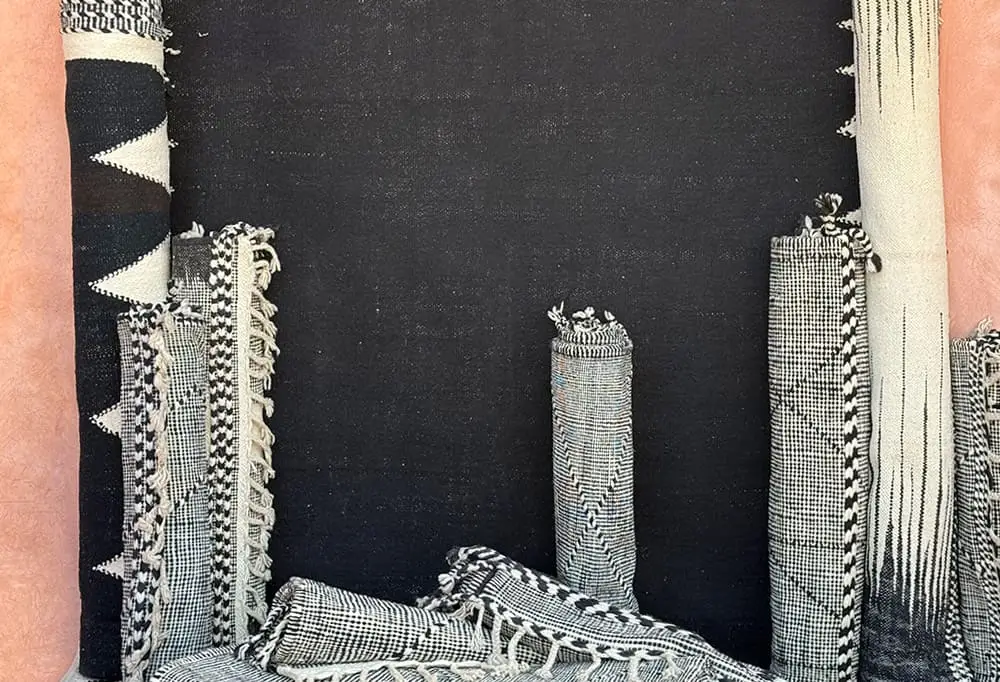
Zanafi rugs hail from the High Atlas and are known for their monochrome, reversible designs. Flat-woven and highly textured, they showcase intricate linear work and often feature braided fringes. Zanafi rugs are distinguished by a unique weaving method known as the chedwi technique—an advanced craft that demands precision and concentration from master women artisans. Made entirely from wool, Zanafis are denser and more durable than typical Kilim rugs, which often incorporate cotton or other fibers. This structural integrity contributes to their longevity and ability to withstand wear, making them a distinctive and enduring flatweave style.
Choose from our few Zanafi rugs, hand-selected for their bold character and artisan depth: Explore our flatweave rug collection
Talsint Rugs
Talsint rugs come from a remote region in eastern Morocco. They are known for their wild, expressive patterns and mix of natural dyes. Often made from a blend of wool and goat hair, these rugs have a rustic charm and a free-form, almost abstract design language that speaks to creativity.
Tifelt Rugs
Originating in northern Morocco, Tifelt rugs are bright, densely knotted, and filled with symmetrical motifs. Their patterns often include central medallions and framed borders, echoing Arab and Berber influences. Tifelt rugs are bold, balanced, and visually structured.
Zayane Kilim Rugs
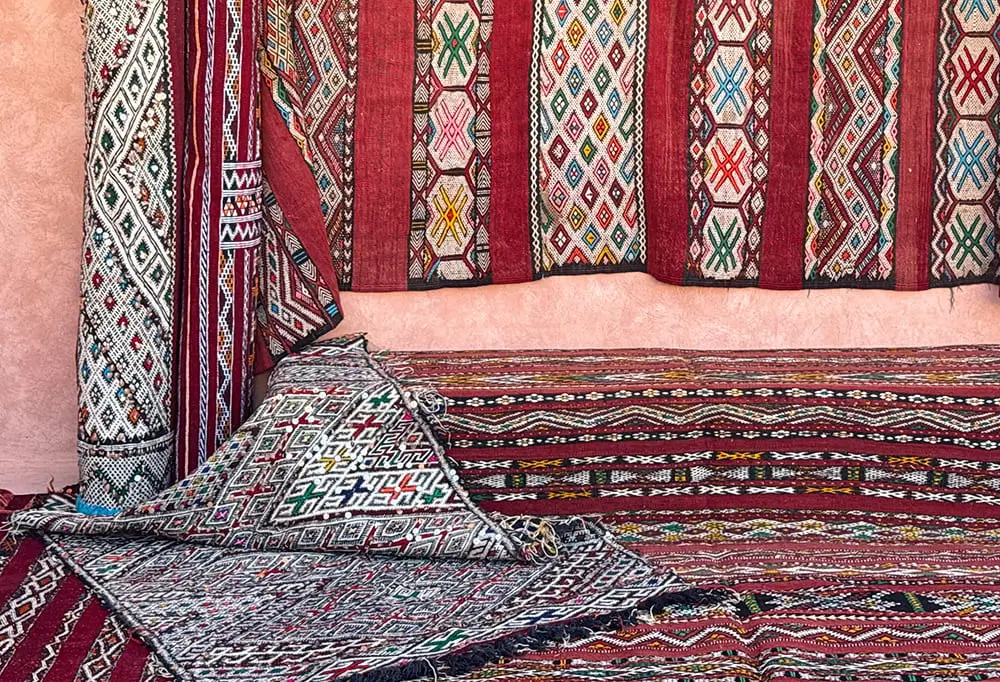
Woven in the mountainous region surrounding Khenifra, Zayane kilim rugs reflect the rich weaving heritage of the Middle Atlas. Crafted by Amazigh women of the Aït Zayane tribes, these flatwoven pieces capture a perfect harmony between structure and spontaneity.
Each rug is entirely flatwoven, composed of horizontal bands filled with geometric motifs such as diamonds, lozenges, and crosses—symbols of protection and continuity passed down through generations. The bold red base, enriched with tones of ivory, black, and bright accents, creates a rhythmic composition that feels both grounded and expressive.
Unlike pile rugs, Zayane kilims reveal their artistry through the precision of their weave. Some incorporate brocaded or embroidered details, adding a delicate play of texture and light. Traditionally used as floor coverings and decorative textiles, these rugs remain admired for their durability, reversibility, and timeless design. In contemporary interiors, they bring warmth, authenticity, and the poetic essence of Middle Atlas craftsmanship.
Mrirt Rugs: The Pinnacle of Moroccan Rug Craftsmanship
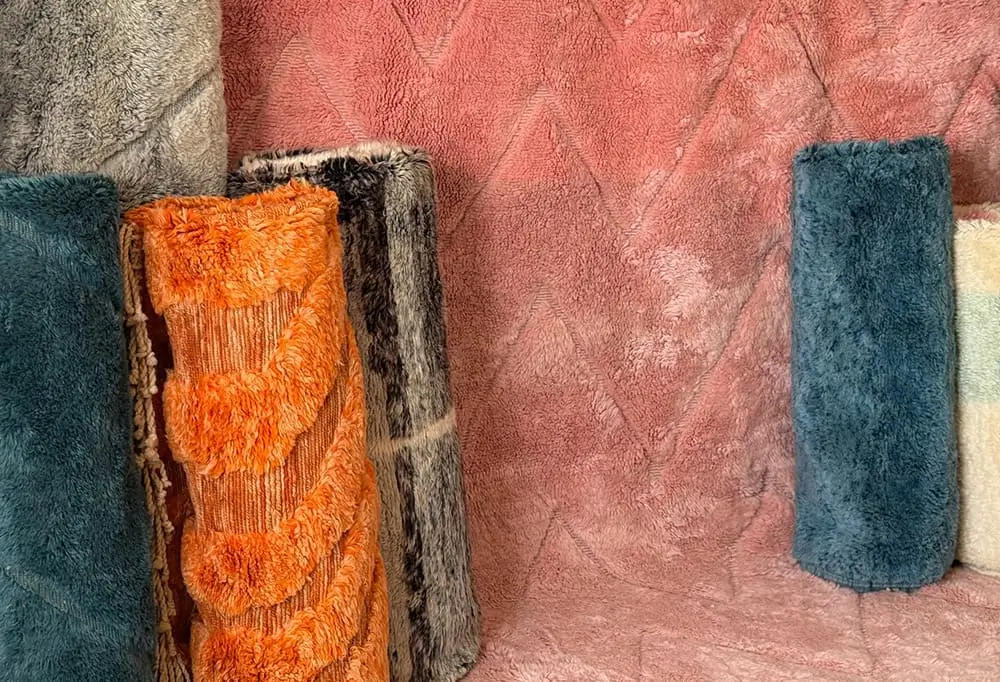
Tucked within the Middle Atlas Mountains, Mrirt is home to a weaving tradition that has quietly evolved into one of Morocco’s most elevated art forms. These rugs stand out for their quiet elegance, technical mastery, and the refined materials used in their creation.
Crafted from high-quality virgin wool sourced from local sheep, each Mrirt rug is soft, dense, and remarkably durable. Women artisans employ a precise double-knotting method, resulting in a plush texture that delivers both visual richness and long-lasting comfort.
With restrained palettes and subtle geometric forms, Mrirt rugs bridge tradition and modernity. Often produced in larger dimensions than other Moroccan rugs, they are designed to ground open living areas interiors with quiet depth and tactile warmth.
This tradition is rooted in the Khenifra province, where isolated terrain shelters the Zayan and other Amazigh tribes. Accessing these weaving communities often requires travel by foot—an enduring reminder of the remoteness that has preserved this cultural heritage.
Each rug carries the emotional imprint of its maker. Woven over the course of weeks, they often commemorate life passages such as dowries, births, and seasonal transitions. Weaving is not only technical; it is a ritual act, performed in communal settings where songs, oral histories, and ancestral memory are embedded in every thread.
Though Mrirt rugs today reflect minimalist sensibilities, their essence remains tied to centuries-old rhythms. They embody the soul of slow craft—a quiet dialogue between function, heritage, and enduring beauty.
For those drawn to artistry, depth, and a sense of home rooted in story: Take a look at our premium wool rugs.
A Living Map of Moroccan Identity
To explore the diverse types of Moroccan rugs is to explore Morocco itself—a country where artistry, heritage, and regional pride are woven into every thread. Each rug tells a story of its place of origin, its weaver, and the community it belongs to. But in today’s market, discerning the authentic from imitation has become increasingly challenging. Many mass-produced pieces attempt to mimic the look of Moroccan rugs without honoring the materials, techniques, or cultural context that give the originals their true value. Knowing how and where to source an authentic Moroccan rug is essential—not only to ensure quality, but also to support the artisans and traditions that continue to keep this heritage alive.
To explore the diverse types of Moroccan rugs is to explore Morocco itself—a country where artistry, heritage, and regional pride are woven into every thread. Each rug tells a story of its place of origin, its weaver, and the community it belongs to. But in today’s market, discerning the authentic from imitation has become increasingly challenging. Many mass-produced pieces attempt to mimic the look of Moroccan rugs without honoring the materials, techniques, or cultural context that give the originals their true value. Knowing how and where to source an authentic Moroccan rug is essential—not only to ensure quality, but also to support the artisans and traditions that continue to keep this heritage alive.
Whether you’re intrigued by the structured elegance of a Tifelt or the expressive bursts of an Azilal, it’s the refined craftsmanship of a Mrirt that truly defines the pinnacle of Berber weaving. These rugs offer more than beauty—they carry a profound connection to craft, culture, and meaning, woven into every knot.
Continue your journey into the artistry and meaning behind each piece: Collecting Guide to Moroccan Berber handmade rugs.




